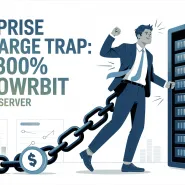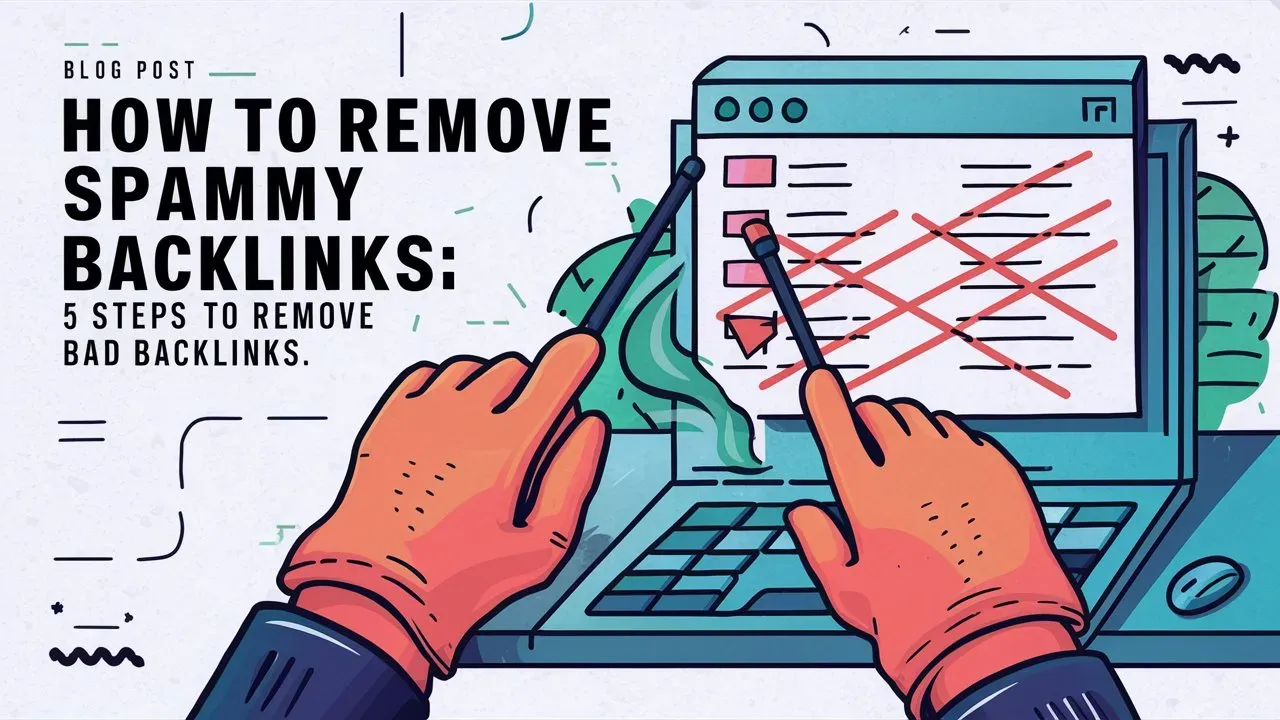Backlinks are important for your website’s authority and visibility. But not all backlinks are good; some can be harmful and even lead to penalties from search engines. If you’re seeing a drop in your rankings or think your backlinks might be hurting your SEO, it’s time to take action. Owrbit’s easy guide provides five simple steps to find and remove bad backlinks. By following these steps, you can clean up your backlink profile, boost your site’s reputation, and improve your search engine rankings. Whether you’re an SEO expert or a business owner wanting to enhance your online presence, this guide will help you protect your site from harmful backlinks.

What Are Spammy Backlinks?
Spammy backlinks are low-quality links from websites that are often irrelevant or untrustworthy. These backlinks usually come from sources like link farms, spammy directories, or sites with little to no real content. They can negatively impact your website’s reputation and search engine ranking because search engines view them as manipulative or deceptive. Essentially, spammy backlinks are seen as attempts to trick search engines into thinking your site is more popular or authoritative than it actually is.

Why Are Spammy Backlinks Harmful to Your Website?
Spammy backlinks are harmful to your website for a few key reasons:
- Search Engine Penalties: Search engines like Google don’t like spammy backlinks. If your site gets a lot of these, you might get penalized and result in drop in search rankings.
- Loss of Trust: Spammy backlinks can make your site look untrustworthy. Visitors might think your site is low-quality or unreliable.
- Bad Reputation: If your site is linked from spammy or harmful sites, it could negatively affect your brand’s reputation.
- Reduced Traffic: Spammy backlinks usually don’t bring valuable visitors. They can lead to lower engagement and fewer conversions.
In short, spammy backlinks can hurt your site’s visibility, reputation, and overall performance.

The Importance of Removing Bad Backlinks :
Removing bad backlinks is crucial for maintaining a healthy and strong website. Here’s why it’s important:
- Protect Your Reputation: Bad backlinks come from low-quality or spammy sites. These can harm your site’s reputation and make it look untrustworthy to search engines and visitors.
- Improve Search Rankings: Search engines, like Google, use backlinks to gauge the quality of your site. If you have bad backlinks, it can hurt your search engine rankings. Removing them can help you rank higher.
- Avoid Penalties: Search engines may penalize your site if they find it has too many bad backlinks. This could result in a drop in your rankings or even removal from search results.
- Enhance User Experience: Bad backlinks can lead to a poor user experience, as they might direct visitors to irrelevant or harmful sites. Removing them ensures users have a better experience on your site.
In short, removing bad backlinks helps keep your site clean, boosts your search engine performance, and ensures a better experience for your visitors.
5 Steps to Remove Bad & Spammy Backlinks :

Step 1: Identify Spammy Backlinks
- Gather Your Backlink Data:
- Use tools like Google Search Console, Ahrefs, SEMrush, Moz, or Majestic to collect a list of backlinks to your site.
- Export this data into a spreadsheet for easier analysis.
- Filter for Spammy Characteristics:
- Domain Authority: Look for links from sites with very low domain authority or trust.
- Relevance: Check if the linking sites are relevant to your niche or industry. Links from unrelated sites are often spammy.
- Link Patterns: Identify links that come from link farms, paid link networks, or have overly optimized anchor text.
- Site Quality: Examine the quality of the linking sites. Sites with poor design, irrelevant content, or a lot of ads may be spammy.
- Use Automated Tools:
- Utilize backlink analysis tools’ spam score metrics to identify potentially harmful links.
Step 2 : Analyze the Impact of Spammy Backlinks
- Assess SEO Metrics:
- Traffic Impact: Determine if the spammy backlinks are causing a drop in organic traffic or rankings.
- Link Quality: Analyze the quality of the spammy backlinks using metrics like domain authority, page authority, and spam scores.
- Evaluate Anchor Text:
- Check if the anchor text used in spammy backlinks is overly optimized or irrelevant. Excessive use of exact-match keywords in anchor text can be a red flag.
- Monitor Changes:
- Track any recent fluctuations in your site’s ranking and traffic that might correlate with the spammy backlinks.
Step 3: Reach Out to Webmasters for Removal :
- Identify Contact Information:
- Locate the contact details of the webmasters or site owners where the spammy backlinks are located. This can usually be found in the site’s contact page, WHOIS database, or using tools like Hunter.io.
- Craft a Removal Request:
- Write a clear and polite email requesting the removal of the spammy backlink. Include:
- The URL of the page containing the link.
- The specific link you want removed.
- Your reasons for requesting removal.
- Write a clear and polite email requesting the removal of the spammy backlink. Include:
- Follow Up:
- If you do not receive a response within a reasonable time frame (e.g., 1-2 weeks), send a follow-up email.
- Document Your Efforts:
- Keep a record of all removal requests and responses to track your progress.
Step 4: Disavow Bad Backlinks Using Google Disavow Tool :
- Prepare a Disavow File:
- Create a text file listing all the spammy domains or URLs you want to disavow. The format should be :
# Disavow filedomain:example.comdomain:anotherexample.com
- Submit the File:
- Go to the Google Disavow Tool in Google Search Console.
- Select your website and upload the prepared disavow file.
- Confirm the submission.
- Monitor Results:
- Keep an eye on your site’s performance and search rankings to see if there are improvements after submitting the disavow file.
Step 5: Monitor Your Backlink Profile Regularly :
- Set Up Regular Backlink Audits:
- Schedule periodic checks (e.g., monthly or quarterly) using your backlink analysis tools to review your backlink profile.
- Track New Links:
- Monitor for new backlinks to ensure that no new spammy or low-quality links are being added.
- Adjust Your Strategy:
- Based on your findings, update your disavow file and removal requests as needed.
- Continue refining your link-building strategy to focus on acquiring high-quality, relevant backlinks.
By following these detailed steps, you can effectively manage spammy backlinks and maintain a healthy backlink profile for your website.
Common Mistakes to Avoid When Removing Backlinks :
When removing backlinks, avoiding common mistakes can significantly impact the effectiveness of your efforts. Here are some key pitfalls to watch out for:
- Ignoring the Context of the Backlink :
- Mistake: Disavowing or removing backlinks without understanding their context or relevance.
- Avoidance: Ensure you thoroughly analyze each backlink before taking action. Determine whether it is truly harmful or if it might have value in some context. Removing a link without context might inadvertently affect your SEO negatively.
- Not Documenting Your Actions :
- Mistake: Failing to keep track of which links you’ve requested for removal or disavowed.
- Avoidance: Maintain detailed records of your removal and disavow requests. Document the URLs, the date of your request, responses received, and any follow-up actions. This helps in tracking progress and avoiding duplicate efforts.
- Sending Mass Removal Requests :
- Mistake: Contacting a large number of webmasters indiscriminately, often leading to poor responses.
- Avoidance: Be selective and targeted in your removal requests. Prioritize links from highly spammy or low-quality sites and craft personalized, polite requests for each one. This increases the likelihood of a positive response.
- Disavowing Links Prematurely :
- Mistake: Using the disavow tool before making a genuine attempt to remove harmful links manually.
- Avoidance: Attempt to reach out to webmasters and request link removals first. Use the disavow tool as a last resort after you’ve exhausted other options.
- Ignoring Link Quality and Relevance :
- Mistake: Disavowing links from high-quality or relevant sites mistakenly classified as spammy.
- Avoidance: Carefully assess the quality and relevance of backlinks before disavowing. Ensure that you are not removing links that could potentially benefit your site.
- Not Updating Your Disavow File Regularly
- Mistake: Failing to update your disavow file with new spammy links or outdated entries.
- Avoidance: Regularly review and update your disavow file as your backlink profile changes. Remove entries for links that have been resolved or no longer pose a threat.
By avoiding these mistakes, you can more effectively manage your backlink profile and improve your site’s SEO health.
Conclusion: Keeping Your Backlink Profile Healthy
Keeping your backlink profile healthy is key to maintaining and improving your website’s search engine performance. Here’s a simple rundown on how to ensure your backlinks are working for you:
- Regular Checks:
- Regularly monitor your backlinks using SEO tools to catch any harmful or low-quality links early.
- Careful Review:
- Analyze each backlink to understand its quality and relevance. Avoid removing or disavowing links without fully understanding their impact.
- Proactive Approach:
- Reach out to webmasters to remove harmful links before using the disavow tool. Only use the disavow tool if you can’t get the links removed manually.
- Detailed Records:
- Keep detailed records of your backlink management efforts. Track which links you’ve requested to remove and the responses you’ve received.
- Strategic Focus:
- Be selective in your removal requests and focus on links that truly impact your site negatively. Avoid broad removal requests that might also affect valuable links.
- Ethical Practices:
- Make sure all your backlink management activities are ethical and fair. Avoid any actions that could harm your competitors or involve unethical practices.
- Ongoing Improvement:
- Regularly update your backlink strategy based on new data and changes in your backlink profile. Aim to build high-quality, relevant backlinks to enhance your site’s authority.
By following these steps, you can maintain a clean and healthy backlink profile, protect your site’s reputation, and improve your search engine rankings. Regular maintenance and strategic management will help ensure that your backlinks contribute positively to your website’s success.
Checkout How to Start an eCommerce Business in India: A Beginner’s Guide
Discover more from Owrbit
Subscribe to get the latest posts sent to your email.










